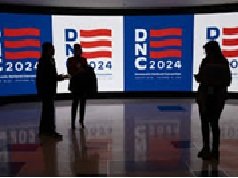By Osman A Hassan
In the aftermath of the 2024 presidential election, many observers have noted a dramatic shift in the dynamics of American politics. The Democratic Party, which has long been a dominant force in shaping policy and discourse in the United States, is now facing significant challenges that threaten its cohesion and future influence. Historically, the Democratic Party has been a coalition of various ideological factions, including progressives, centrists, and moderate liberals. However, following the 2024 election, a deep divide seems to have emerged, with the party struggling to reconcile its disparate wings. The progressives, often pushing for bold reforms on issues like climate change, healthcare, and economic inequality, are at odds with the more moderate members who argue for pragmatism and gradual change. This tension has been exacerbated by the party’s loss in key battleground states, which has left many questions about the party’s ability to unite its base and win future elections.
The Democratic Party’s struggles can also be seen in its leadership vacuum. The exit of long-standing figures, both in the executive and legislative branches, has left a leadership gap that has yet to be filled with a strong, unifying figure. This lack of clear leadership has contributed to a sense of uncertainty within the party, with various factions jockeying for influence and direction. The result is a party that seems directionless, failing to maintain the cohesion needed to forge a clear and compelling narrative for the future. Moreover, the shifting political landscape in the United States has contributed to the erosion of the Democratic Party’s traditional strongholds. Younger voters, who once formed a reliable part of the Democratic base, have become increasingly disillusioned with the party’s failure to deliver on key promises. Many of these voters feel that the party’s leadership has become disconnected from their needs and aspirations, which has led to lower turnout and a lack of enthusiasm. In this context, the Democratic Party’s future is uncertain.
While there are remains of a significant portion of the electorate that aligns with the party’s core values, the challenges of unity, leadership, and relevance in an increasingly polarized political environment are formidable. Hence created Democratic Party’s identity crisis after the 2024 election that marked by deep internal conflict and reevaluation of its direction. Having faced significant losses or challenges, the party’s core struggles would likely revolve around defining who they are, what they stand for, and how to reconnect with the American electorate. For years, the Democratic Party has been a broad coalition, encompassing progressives, centrists, moderates, and establishment figures. However, this diversity of thought has often led to friction. After a potential defeat in 2024, these tensions would likely come to the forefront. The progressives pushing for more radical reforms such as universal healthcare, green new deals, and free college might feel alienated by a party that seems unwilling to go as far in addressing climate change, inequality, or social justice. On the other hand, more moderate members of the party might feel that the progressives’ agenda is too far left and unsuited to win general elections.
This division cause the Democratic Party to experience an identity crisis, trying to reconcile competing priorities, ideologies, and visions for America’s future. The party may struggle to answer fundamental questions. For example, Should the party double down on progressive ideals to energize younger voters, or should the party attempt to reclaim the center to appeal to moderate and swing voters? Without clear answers, the party finds itself unable to establish a cohesive message that resonates with voters across the political spectrum. Additionally, the Democratic Party face challenges in leadership. After the election, older figures retire or fade from the stage, leaving the party scrambling to find new leaders capable of bridging these divides. The absence of a strong, unifying figure could intensify feelings of disarray, as potential leaders may differ dramatically in their approaches to policy, strategy, and party unity. This pave way the party’s identity crisis that also influenced by its relationship with key constituencies, such as labor unions, communities of color, and suburban voters. Traditionally, these groups have been pillars of Democratic support, but demographic shifts and changing attitudes mean the party could be struggling to maintain these allegiances. Labor unions, for example, increasingly align with populist or conservative forces, while suburban voters, who once leaned Democratic, swayed by Republican messaging on issues like crime, education, or the economy. Considering these challenges, the Democratic Party faces a difficult reckoning in the years following the 2024 election.

/source VOA
For instant the Democratic Party is home to various factions with differing priorities, such as the progressive left, centrists, and more moderate Democrats. After a potential loss in 2024, these divisions became more pronounced, as each faction pushed for its vision of the party’s future. Some progressives advocate for more aggressive policies on healthcare, climate change, and social justice, while centrists may argue for more pragmatic, incremental approaches. The Democratic Party has historically relied on a coalition of minority groups, women, young voters, and urban residents whose demographic shifted, particularly in battleground states, have complicated this formula. Suburban voters, once solidly Democratic, have become more divided in recent years, while some working-class and rural voters who supported the Democrats in the past have increasingly leaned toward the Republican Party. Looking at the past and in recent years, voter turnout has been inconsistent, particularly among younger and minority voters, who are critical to the Democratic base. Similarly, after the 2024 election, the Democratic Party may face a leadership crisis. Many established party leaders step down, either due to age, the results of the election, or dissatisfaction within the party. This will create a vacuum that leaves the party in a fragile position. Finding new leadership that can unify the party, inspire its base, and forge effective governance is critical to its functionality that thaws disagreements over leadership styles or policy approaches that hinder the ability of the party to function cohesively in Congress cause of different factions vying for influence that struggle to pass major policies.
The 2024 U.S. presidential election marked a pivotal moment in American politics, with far-reaching consequences for the Democratic Party. As the Democratic Party grapples with the fallout from the election results, it faces an array of challenges that have been amplified by the media landscape and external political forces. These factors have contributed to what can be described as a “loose loom stitch” loss fragmentation and vulnerabilities the party is experiencing in the wake of the election. The media has always played a significant role in shaping political narratives, but its influence has reached new heights in the age of digital communication. The 2024 election was marked by intense media coverage that often sensationalized division, both within the Democratic Party and in the broader political landscape. For the Democratic Party, media coverage at times painted a picture of internal disarray, with a focus on infighting, policy disagreements, and leadership challenges. This led to a perception of weakness and disunity among voters who were seeking a party that could present a unified vision for the future. Likewise, the role of social media as a tool for both disseminating information and spreading misinformation played a major role in shaping the narrative. The rapid spread of misinformation and polarizing content on platforms like Twitter, Facebook, and Instagram further deepened divisions within the party, especially on contentious issues like healthcare reform, climate change policy, and the economy. This created an environment where social media algorithms prioritize sensationalism and engagement, the Democratic Party was caught in the crossfire of exaggerated claims, creating a fractured political discourse that hindered its ability to present a coherent message. The press often focused more on sensational scandals and controversies, overshadowing the party’s achievements and progressive policies. As a result, voters were frequently exposed to narratives that did not accurately reflect the complexity of the issues at hand, leading to voter disillusionment. The constant barrage of negative coverage left little room for nuanced discussions of policy, alienating moderates and progressives alike.
Beyond the media, external political forces have significantly shaped the Democratic Party’s difficulties after the 2024 election. One of the most powerful factors contributing to the party’s fragmented state is the broader trend of political polarization. The United States has seen increasing ideological divides, particularly along partisan lines, with each party moving further away from the political center. This ideological polarization has made it challenging for the Democratic Party to maintain a broad coalition of voters. The party’s progressive wing has pushed for bolder policy proposals, while moderates have resisted, creating internal conflict and disarray. This helped the Republican Party, effectively capitalized on the polarization of American politics by presenting a unified front under its leadership. The contrasting approaches of the two parties with the Democrats divided between centrists and progressives have made it easier for the GOP to portray the Democrats as indecisive and fragmented. This external force of a highly organized opposition party, with its own effective media strategies, has further exacerbated the challenges for the Democrats.
As the Democratic Party navigates its post-election challenges, its struggles are shaped by both internal and external forces. The media’s role in amplifying division, coupled with external polarization, has created a perfect storm of factors that has undermined the party’s unity. The Democratic Party’s inability to present a cohesive and unified platform in the aftermath of the election has left it grappling with a weakened base and a diminished sense of purpose. To recover, the party must find a way to reconcile its internal divisions and present a united front. This will require thoughtful leadership that prioritizes dialogue and compromise, focusing on building bridges between different factions within the party. The Party’s “loose loom stitch” lost knit after the 2024 election attributed to a confluence of factors, with the media and external political forces playing pivotal roles that can help the party confront head-on, learning from the missteps of the past and working to rebuild its unity and vision for the future.
Osman A Hassan
Email: Abayounis1968@gmail.com


Leave a Reply